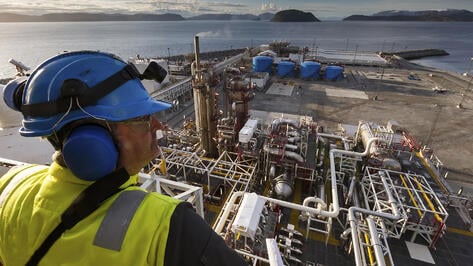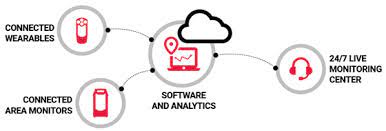
At every point in oil and gas production, from the extraction of raw materials to transportation and storage, to refining and distribution processes, oil and gas operations require accurate, real-time monitoring of safety conditions. This immediate visibility protects workers, facilities, and equipment from damage, ensuring every worker gets home safe at the end of the day.
With the advent of digital transformation and IoT, connected safety solutions have progressed programs from reactive compliance to proactive incident prevention, reducing risks to facilities and people alike.

What is a connected safety solution?
Connected safety solutions consist of a network of cloud-connected devices, including area monitors and personal wearable devices coupled with an online dashboard, provide full visibility into the safety of facilities and workers. The data streamed from those devices deliver powerful reporting capabilities to a manager’s fingertips, such as real-time compliance status (ensuring bump tests and calibrations are completed for the entire fleet of devices), but also that the devices are charged, turned on and actively being used throughout a shift.
This information can be viewed from anywhere in real-time without having to wait until after a device is docked to receive the data. Data analysis can also identify and predict potential hazards so corrective action can be taken before they become an incident.
How do connected safety solutions reduce risks to facilities and workers?
The easiest way to explain connected safety is to provide examples from the field. Here are examples of common risks in the oil and gas industry and how connected safety solutions can reduce them.
Connecting lone and remote workers.
A frequent scenario in the oil and gas industry is working alone or in remote areas which is especially true in upstream and midstream operations where workers may travel to various locations throughout a shift. It’s also the case in large downstream facilities where workers can be out of sight (and sound) from their peers. Hazards lone and remote workers face are diverse, including accidents while traveling, toxic or explosive gas exposures, health events, falls, inclement weather, and dangers from wildlife.
Protect your most valuable resource, your workers.
The fatality rate in the Oil & Gas industry is seven times greater than the rate amongst US workers in general – 25.1 / 100,000 / year. (CDC)

A connected safety solution uses wearable devices with sensors and functionality to automatically detect falls, lack of movement, and missed check-ins, any of which could indicate that a worker needs assistance. Lone workers can also activate SOS alerts to immediately connect them to safety monitoring personnel in the event of an incident. If exposure to toxic or flammable gases is a potential risk during their workday, lone worker devices can be (re)configured to include single- or multi-gas detection capabilities. Real-time awareness of their people provides relief to safety team leaders knowing that someone is monitoring their people on a constant basis should the worst occur.
At many remote locations, cell service is limited, making it difficult for a worker to call for help if they are in a dangerous situation. The monitoring and communication capabilities of satellite-connected safety devices, such as the Blackline G7x Multi-gas Pump Detector, can be the difference between life and death. And if the work requires going to wellhead locations past the end of service roads, the magnetic satellite bridge can be easily moved from a truck to an ATV so the worker is always connected regardless of where the job takes them.
Conclusion
Working alone is a regular occurrence for employees in the oil and gas industry, which exposes them to numerous hazards. Connected safety solutions provide real-time area monitoring for full worksite visibility, as well as data insights that can help predict and prevent incidents. These solutions ensure the wellbeing of lone workers is always accounted for while on the job—and that if a problematic situation arises, they’ll immediately get the help that they need.
 Learn more:
Learn more:
Watch G7 Videos
Contact Us
Share This:




 CDN NEWS |
CDN NEWS |  US NEWS
US NEWS 


























